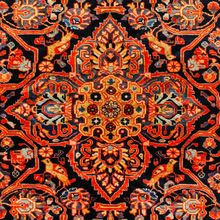Malayer Rug
| Malayer Rug | |
|---|---|
 Design of Malayer Rug (Rugman) | |
| General information | |
| Name | Malayer Rug |
| Original name | قالی ملایر |
| Alternative name(s) | Malayer Carpet |
| Origin | |
| Category | Village |
| Technical information | |
| Common designs | Medallion, Geometric, Herati |
| Common colors | Red, Blue, Yellow, Navy Blue, Orange |
| Dyeing method | Natural, Synthetic |
| Pile material | Wool |
| Foundation material | Cotton |
| Knot type | Symmetrical (Turkish) |
Malayer rugs originate from Malayer, located in the southwestern area of the Hamadan Province in western Iran. The semi-nomadic people have shunned the modern ways in favor of using the same techniques and materials that have been used for generations. This region of Iran is sometimes referred to as “the land of grapes” and for this reason you may see it incorporated into the overall design of a Malayer Persian carpet. The rugs are single wefted – also called “Sennah Baft” or Hamadan weave – meaning that there is only one shot of weft between each row of knots. Talented weavers create Malayer rugs using the Turkish knot. They are well constructed of very good wool and range in quality from coarse to finer than a Hamadan Persian carpet.
History
Malayer is a city located in the southwestern area of the Hamadan Province in western Iran. It is considered one of the oldest weaving villages in Hamadan. Malayer is known to weave the finest rustic rugs and runners in the province.The rugs are known in the antique market from the early nineteenth century.
Malayer rugs have a cotton foundation and a wool pile. Early weavings were made mainly on a wool foundation. The Turkish (symmetric) knot is used.The rugs are tightly woven with a low-cut pile.
Malayers have semigeometric designs in an all-over or medallion style. The designs have palmettes with leaves and vines, traditional motifs of Boteh (paisley), Herati (fish), Shrub, Vase, and at times the Tree of Life. The rugs can feature primitive tribal motifs such as animals, birds, and human figures in the field. Triclinium Carpets designs were also made in Malayer, and they occasionally appear in the antique market the nearby village of Mishan, twenty kilometers away from Malayer, produces rugs that are similar in design, coloration, and technique to Malayer weavings. Mishans have a finer weave than Malayers, and in the Tehran bazaar they are called Mishan Malayer.
Malayer field colors are mostly reds, ivory, or dark blue, but at times, camel or light blue is used. Besides these colors, different shades of blue, brown, camel, gray, orange, and green are employed for the borders and design elements. Dark blue or dark brown is used for design outlines. Important to note is the fact that some of the older Malayer rugs have issues with the red dye bleeding in the background, usually a result of a shortened dye process.
Malayer weavings are woven in formats ranging from small bag face rugs to approximately six feet by four feet. Runners and gallery sizes are made in a variety of lengths. Rare room-size carpets exist and can be found in the antique market. Malayers are generally good to fine in grade quality. Some lower-grade Malayer rugs were categorized as one of the Hamadan Mosul Rugs. Mosul rugs were marketed successfully worldwide as an inexpensive alternative to Caucasian and Anatolian rugs. By the late twentieth century, some Malayer weavers switched from using traditional designs to patterns similar to those in neighboring areas in accordance with the demand of domestic and foreign export consumers.[1]
See also
| Search for Malayer Rug on Wikipedia. |
References
- ↑ Moheban, 2015, 367-378
Bibliography
- Abraham Levi Moheban. 2015. The Encyclopedia of Antique Carpets: Twenty-Five Centuries of Weaving. NewYork: Princeton Architectural Press.